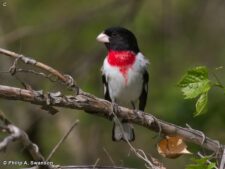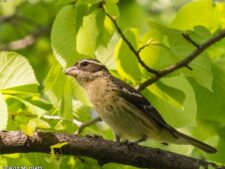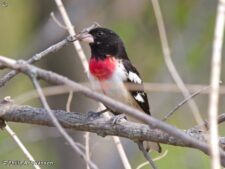
7 to 8.5 inches long. The Rose-breasted Grosbeak is a medium sized bird with a large conical bill. The adult male has a rose colored triangular breast patch. It has a black head and upperparts. The underparts are white. There are white patches in the wings and white spots in the tail. In flight part of the underwing shows red. The female is quite different. Her head is dark brown with a white crown stripe and pale eyebrows. She has dark brown upperparts and white underparts with heavy streaks. In flight part of the underwing shows yellow. The first fall male is similar to the female except it has a rich buffy breast with a few pink feathers and red wing linings.
The Rose-breasted Grosbeak is a common breeder arriving as soon as mid April and departing as late as November 22.
The Rose-breasted Grosbeak is relatively common and lives in primary and secondary deciduous and mixed forest and thickets, as well as alongside humans in parks and gardens. Since it uses edge and secondary habitats, it is relatively tolerant of human disturbance to habitats. At one time it was considered a pest because it was fond of tree buds, flowers, and fruits. It was also considered a beneficial species because it eats potato beetle larvae, scale insects, and other insects injurious to crops. The Rose-breasted Grosbeak song is a husky warble of whistled, robin-like phrases at a slow and steady pace that is often interspersed with the grosbeak’s “chink”. The call is a mechanical sounding “eek”. It is one of few species reported to sing while sitting on the nest.
Disclaimer: The content of NatureSearch is provided by dedicated volunteer Naturalists of Fontenelle Forest who strive to provide the most accurate information available. Contributors of the images retain their copyrights. The point of contact for this page is: Phil Swanson.






